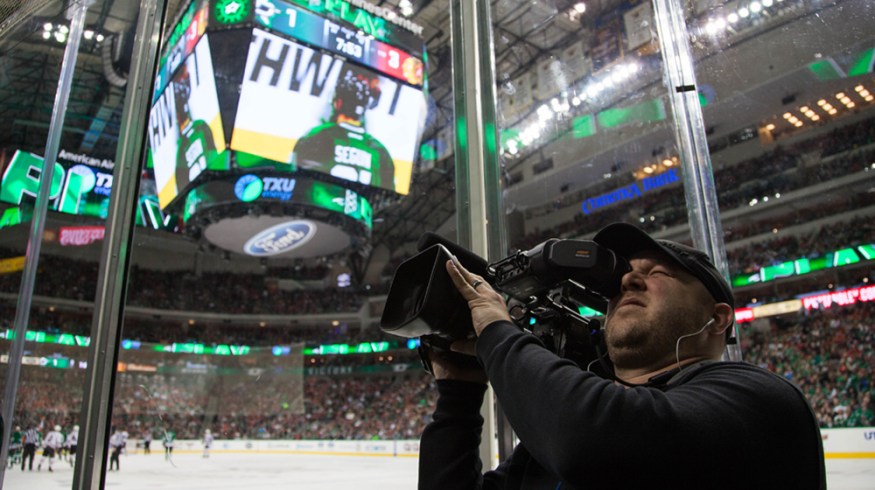
The Media Machine Behind the Dallas Stars
The Dallas Stars invite PremiumBeat to an exclusive behind-the-scenes look at the video production and broadcast of an NHL hockey game.
Images from Caleb Ward, PremiumBeat
It’s just past noon in Dallas, Texas. Tonight the Dallas Stars take on their division foes and defending Stanley Cup champions, the Chicago Blackhawks. This year, the Stars have been atop the league in a dominating form not seen in Dallas in decades.
Though the team has seen its ups and downs the past few seasons, either just missing or barely making the playoffs, one thing has been consistent — the fantastic media team. From in-house video production, broadcast, and even social media, the Stars are seemingly unrivaled in the delivery of their content.
Few NHL teams, like the LA Kings, have kept fans as engaged and entertained as the Stars. Perhaps the most well known thing about the media team is the constant stream of jokes coming from the Stars jumbotron.
With all the excitement in the back office, tonight’s game resembles the potential playoff match this game will become. The following is a recount and inside look at what it takes to bring such an exciting match to the fans in the arena and to those watching at home. This is a look at the NHL Dallas Stars game day video production.
12:30pm – Arrival
I’ve just arrived at the American Airlines Center (AAC). The venue was recently named the 4th busiest arena in the United States and 10th busiest in the world. Deep in the heart of Texas, the AAC hosts hundreds of events and concerts every year, as well as playing home to the NBA Dallas Mavericks and NHL Dallas Stars. The success of the venue has allowed them to constantly upgrade the arena with the latest tech, much of which I will soon get a glimpse of.
I walk over to the administration doors and head through security. Upon entering the building I am met by the Senior Director of Game Presentation, Jason Danby. Danby will be my guide for the day, showing me around the arena prior to puck drop.
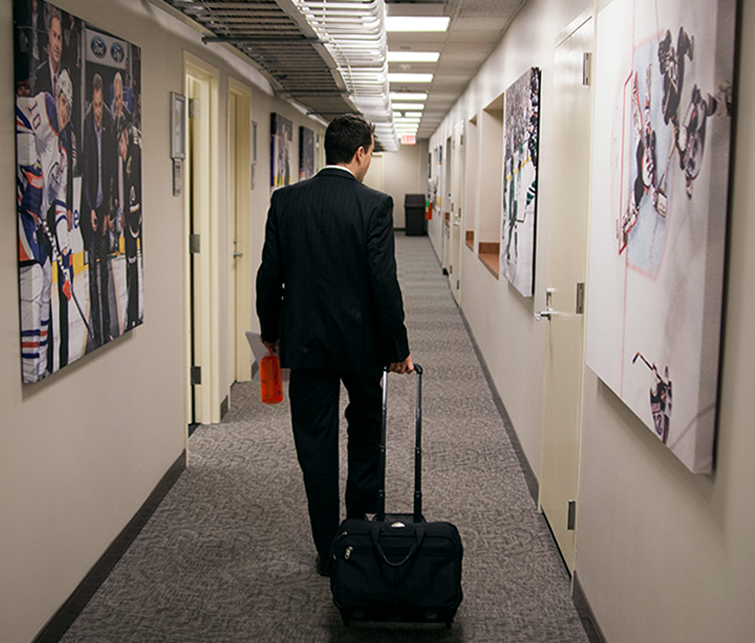
A little bit on Jason Danby – He worked on sports game day packages throughout college, creating elements for football, basketball, swimming, and other sports. He landed a job with the Dallas Stars as an intern in the Public Relations department. He would later move into a role as a video editor with the team, working his way up to his current position. He just started his tenth season with the Stars.
Danby leads me towards the control room, which is located on the ground floor underneath the north side of the arena. Directly over my head are sections 112 and 113. The tunnel is currently housing all the additional seating used for basketball games. We walk past some vending machines and the elevator bay, making our way into the control room.
We enter a tech mecca absolutely filled with screens, workstations, a seemingly endless array of data servers, and a switcher board only rivaled locally by AT&T Stadium – home of the NFL Dallas Cowboys. Danby tells me that the success of the venue allows them to have equipment many sports teams only dream of. It also doesn’t hurt that the Dallas Mavericks share the space, as Mavs owner Mark Cuban is known for his dedication to creating the ultimate fan experience.
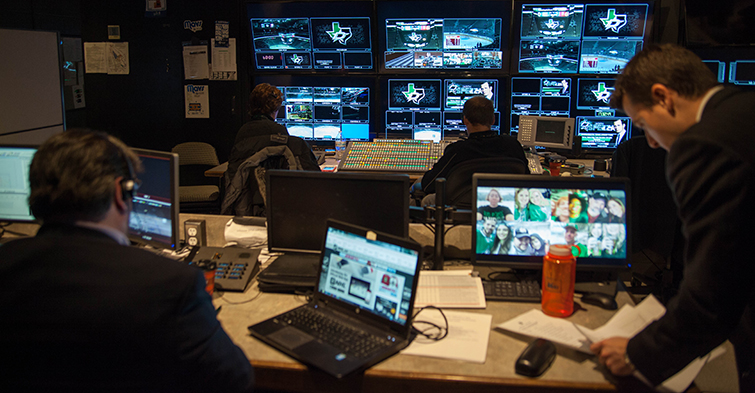
It’s still early for a 7:00pm game, so the control booth is mostly empty at the moment. Danby and I jump into conversation, as this is the only downtime he will have today. We talk about his time working video boards in college and his growth with the Stars organization. For those of you with no knowledge of the franchise, Danby joined the Stars in the middle of a tumultuous decade.
His first year with the team was after the NHL owner’s lockout of 2004-05. The lockout left a large impression on him, as he saw the team struggle to get fans back in the stands after an entire season without hockey. Unbeknownst to Danby at the time, those years would be incredibly formative in regards to fan engagement.
As the years progressed, the Stars fluctuated as a team. They once reached the conference finals in 2008 and later flirted with playoff births, ultimately unsuccessful most years. In 2010, then-owner Tom Hicks’ company defaulted on a bank loan backed by the Stars and interest in the American Airlines Center. The team went bankrupt and was then managed by the National Hockey League. The Stars were auctioned off and purchased by Tom Galgardi, ushering in a new era for the team.
When Danby switched into a production role, he was one of only a handful of crew members in the media department. Since the team found new ownership, the entire franchise has benefitted — and the media department has grown enormously. Danby is quick to credit his own boss, Jason Walsh, for the growth.
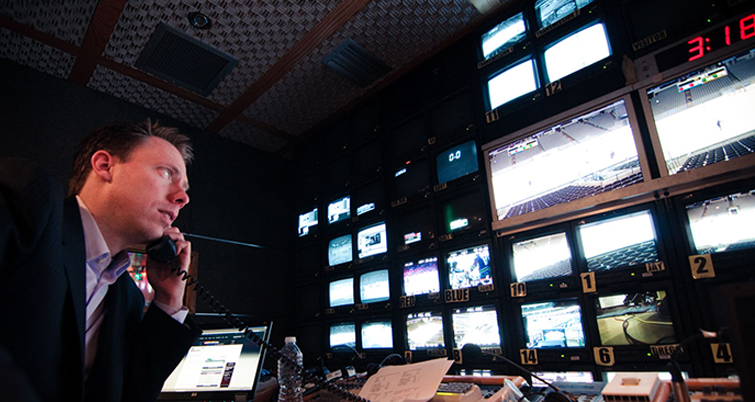
Image via TM Television
Jason Walsh has been with the Dallas Stars for nearly twenty years, now serving as the teams Vice President of Broadcast and Entertainment. Other teams in the NHL only manage their internal video production, and leave the television broadcast to a regional station. Walsh heads both the in-arena team and the broadcast team, something that sounds like it shouldn’t work — but in Dallas it somehow does.
All video production, as well as radio and arena entertainment, goes through Walsh. On game days, Jason Walsh will work the broadcast truck as the lead producer and Jason Danby will run all in arena video and entertainment.
Back at the team’s headquarters in Frisco, Texas, Walsh’s office is part of the media department cave. That office has grown under his leadership. Where the team would once hire contract editors and video producers, the Stars now have full-time employees in house.
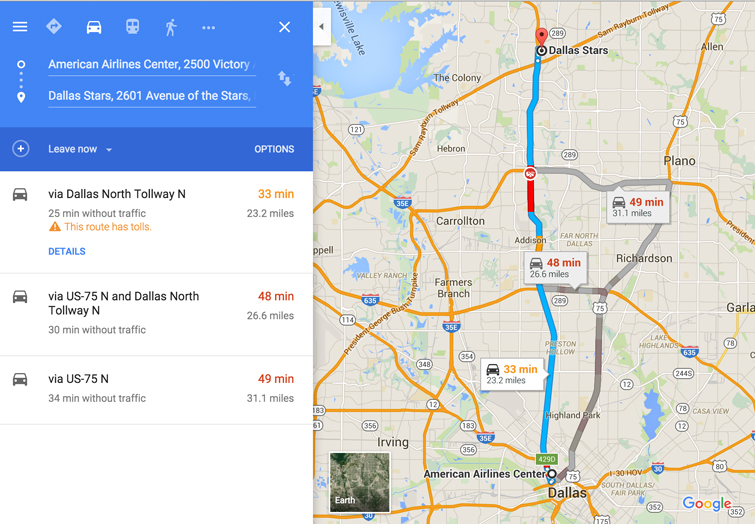
Quick side note on the office location: Frisco is 35 miles away from the arena, meaning the staff has to be incredibly prepared with all elements. The team uses XD discs, a VPN, and external drives a majority of the time — so if something is left behind in the office, it would take a staff member at least an hour to bring the material to the arena.
Editors like Jerry Miranda, Hunter Harrington, and Kevin Harp produce hundreds of hours worth of content. In the office, a majority of the work is done in AVID on the ISIS server. The server includes footage from the past decade, while older material is archived on discs in storage. Additionally, editors have the Adobe Create Cloud, allowing them to do quick work in After Effects if needed.
Miranda is known to edit videos with a “lot of heart and emotion.” He often produces the major opening videos seen on the center hung video board. Harp and Harrington produce many of the video bits and interviews seen in-arena. Harp also works as the production editor during games, working the Crossfire broadcast system that sends all element packages to the board. Many of those elements include the fantastic graphic packages rendered by Jeff Neal, the teams Director of Visual Effects.
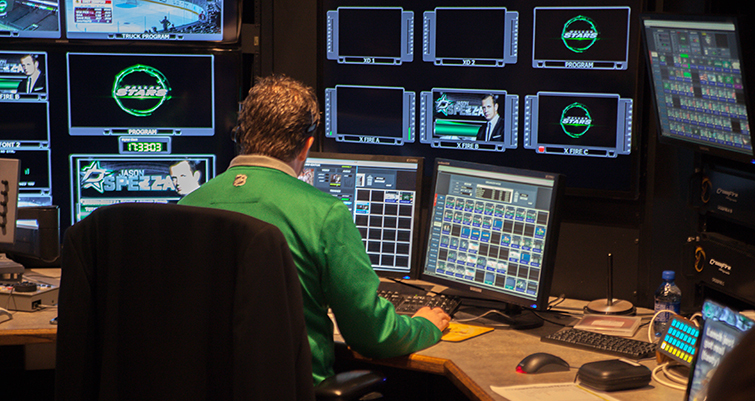
While Danby and I are deep in conversation, Kevin Harp has been loading all the footage into Crossfire — working with the audio technician to verify all that elements with sound are functioning correctly. For example, if a referee blows a whistle, Harp will have the Power Play graphics package ready to hit all of the boards. This includes the center hung boards, the ribbons around the arena, and the two large boards on the north and south sides.
Also in the room is Shae Bryan, the production coordinator. She is currently finalizing minor details in the scripts and timelines. I can see her verifying the schedule, ensuring a future game is indeed at 7:00 and not 7:30. These are the little details she will hand over to the broadcast duo of Dave Strader and Daryl “Razor” Reaugh.
As the four of us sit in the control room, I ask when we should expect the rest of the crew. I’m told “any minute now” — realizing that time had already been flying by.
2:00 – Call Time for Crew
As we await the arrival of the crew, Danby and I get into the creation of content. He explains the creation of his “11 Parameters” that were born out of the NHL lockout. He tells me about the first time he sat down and went through every single game day element that had been produced up to that point. If he had no emotional response, he immediately killed it.
At the time, the team was simply listing information on the video board. List of starters, scratches, opponents rosters, safety warnings, etc. All of that content was removed. He tells me that shows can get cluttered really quick, so the ineffective stuff was to be removed and replaced with player content.
This is one of the biggest steps the media team first took. Instead of showing a list warning fans to watch out for flying pucks, they filmed a player issuing the warning. That content worked on two levels. It accentuated the warning and got fans to pay attention, while also showcasing the player.
Those videos worked and have since spawned dozens of other player segments played throughout games. The freedom the media department has allows them to take more risks. As they have received such positive reaction to their risks, they’ve been able to push the envelope further. This is where other teams in the league (and other leagues) struggle to compete with the Dallas Stars.
This is show business. If it’s not entertaining, it’s not good. You have to find a way to may things entertaining. Most other teams lose it because of how corporate it is.
The 11 Parameters include plenty of check points like “informative, entertaining, hockey-centered,” but most important is sponsorship. Content that is sponsored is guaranteed to play over bits that they may or may not have time for. By having so many players featured in segments, the team has found sponsorship increasing. That said, producing player content has to be scheduled months in advance.
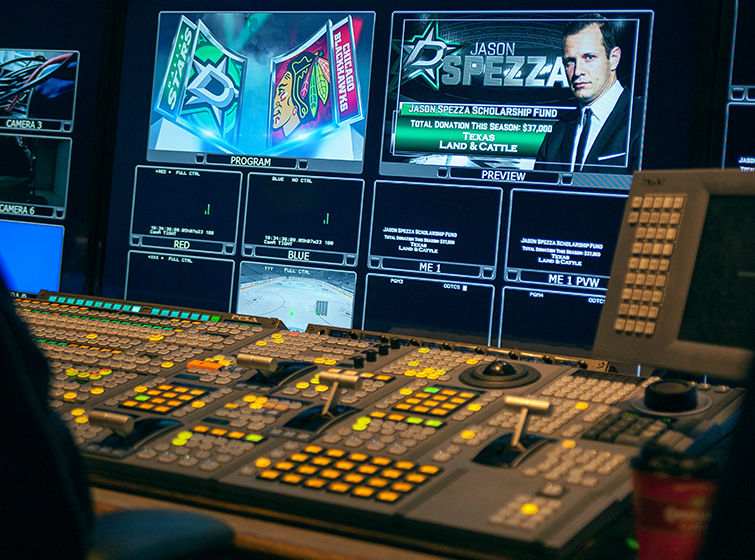
Content for the entire season is planned in the summer months, just after the NHL releases the schedule. They set focus on division rivals first, determining ways to poke fun at the team. It should be noted I said team, as the media department does enforce their own rules in regards to their jokes. They don’t identify individual players on the opposing team. They pick the appropriate way to make the best jokes without using adult humor. They know to push the line, but not cross it. If the Stars suffer a tough loss, fans can still leave the arena with a good bit or joke.
After divison rivals, the Stars set eyes on other opponents. Recently they have taken to poking fun at the teams from Canada. They gained national headlines for their jokes about Justin Bieber’s arrest when playing the Toronto Maple Leafs. Against Vancouver, the Stars tortured their own fans by only playing songs by Canadian natives — Nickelback. Danby tells me that the Stars players were trying not to laugh after four songs – in total they played twelve.
Tonight the team has a packaged bit targeting Chicago fans. When the Blackhawks last played in Dallas two months prior, the media team sent a camera man into the stands to capture Chicago fans texting on their phones. Tonight, they will premiere a bit showing what Chicago fans were typing on their phones.
The success of the bits have also allowed more joke content produced with players. A majority of the player videos are shot during Media Day. Players like Antoine Roussel, one of two French born hockey players in the NHL, hosts Cinema of Antoine, in which he jokingly reviews classic French films. The Stars also have two goaltenders from Finland. Together they speak in the native tongue in Words With Finns. The goal is to get fans to guess what they are saying. Most recently the players said (in Finnish): “Words with Friends isn’t that popular anymore, but this is a great pun.”
Danby tells me that the media team can never lose sight that this is all about the team and the players. The added benefit of this content — it appeals to the part of the crowd that is immune to sports.
It’s a variety show. The video team is the wingman. We get [the players] to look good. Highlight them, or when they are down cause a diversion.
The crew members are starting to arrive. One of the first to walk in is director Terri McCormack. Terri has called over 1000 Dallas Stars games. (She also directs the massive video board for the Dallas Cowboys, as well as countless television shows.) During the game, Terri is the one actually calling the shots. She will direct the entire crew in the control room and the in-arena camera crew.
McCormack has a choice of nine camera angles during the game. Several camera crew members will be shooting with an array of Sony XDCAMs, including the Sony PDW700. Danby tells me that “XD is the way to be” and that he and Jason Walsh have been trying to make XDCAMs the standard within the NHL and Fox Sports. The team also just purchased a new Sony HSC-300RF. The camera crew also uses a Canon 7D to capture fan footage for bits. Additionally, GoPros are mounted in each of the penalty boxes.
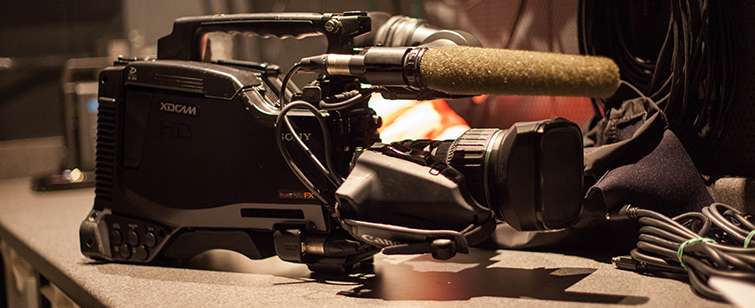
A majority of the crew has now arrived. The replay crew has jumped into editing highlights from the previous games against Winnipeg and Colorado. They are using the EVS replay system to create the content that will play prior to the game. They notice not all the footage is available, so Danby heads down to the broadcast truck to grab a copy of the game. He’s back in two minutes. Work continues immediately.
Next to enter is font operator Ben Rebstock, who quickly grabs a seat and opens up Lyric Pro. The program allows him to edit all the text that will appear on screen. He immediately gets to work typing the names of the referees, starting players, and the Happy Birthday list. The text elements are layered over live video footage, Crossfire elements, or used to create original images. Rebstock is behind many of the humorous lists the Stars have become known for.
3:00 – Birth of a Bit
Now that all of the crew has arrived, Danby announces that they will be shooting a bit in the control room for next week’s game on Valentine’s weekend. The premise is a contagious disease causes people to sexually play an inflatable saxophone to the tune of George Michael’s Careless Whisper. A prepackaged bit will play before cutting to live footage of the mascot handing out inflatable saxophones to the crowd, ultimately ending with a font package wishing fans “a very saxy Valentine’s day.”
This will either be the worst bit, or a 6 out of 10.
If the jokes don’t work in the edit, they will kill it. Without question, the whole crew is ready to get in on the shoot. They know that they have to really embrace it to sell it. For the next thirty minutes, Hunter Harrington shoots the crew with the Canon 7D. He will be the one ultimately responsible for shooting and editing the piece.
After they wrap the bit, each crew member finishes up their final duties before heading to lunch. Terri McCormack meets with the replay crew to go over timing. The font packages are finalized, and the Crossfire system is all set for the game. Before heading to lunch, Danby makes a quick announcement praising one of the team members for their hard work over the last week. He hands them a game-used puck from the last Stars game.
4:00 – Lunch Break
We leave the control room to walk down the corridor to the lunch room. I stand in line with a cavalcade of staff members, from the facility crew to broadcaster Razor Reaugh. I grab some tilapia and veggies and head to a table to sit with Danby and some arena staff members. Over dessert, Danby tells me about all the little details that go into every game.
It’s weird to plan so much ahead of time. But if something goes wrong, it’s my fault.
It’s then I hear of the plan to find a fan wearing a Patrick Sharp Chicago Blackhawks jersey. (The Stars acquired Sharp from Chicago during the offseason.) The goal is to get a fan to take off their Sharp Blackhawks jersey and exchange it for an autographed Sharp Stars jersey — and of course catch it all on camera.
After lunch, Jason Danby and Hunter Harrington convince me to be part of the Valentine’s Day bit. The original idea was to have me walk up to a ticket booth to purchase tickets for the game, but in an inspirational moment — the bit drastically changes direction. They want to convince the television broadcast crew to be part of the Valentine’s video. Without second guessing the idea, they grab the camera and we head up to the platinum level.
5:00 – The Broadcast Booth
The platinum level is the middle tier of the arena. The section houses many of the venue’s box seats and corporate-sponsored bars and dining areas. It also houses all of the broadcast booths. On one side of the arena is a section for the play-by-play and color crews, and the north end houses the Fox Sports television booth.
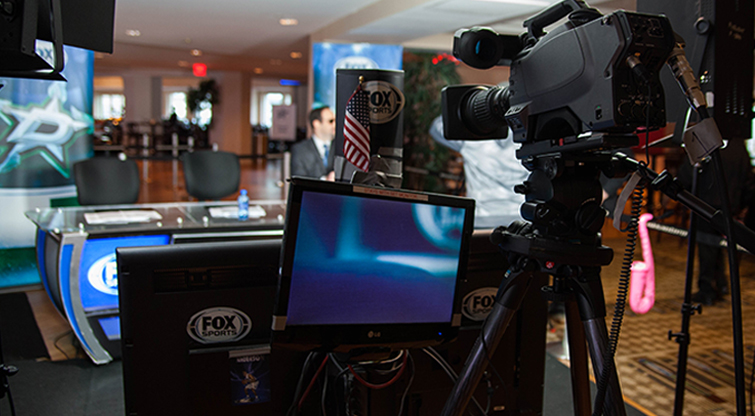
The Fox Sports booth is a semi-permanent fixture in the arena. The booth has a high-end broadcast table, a Sony HXC-100 affixed to a tripod, and two FloLight FL-220AW lights on each side of the camera. There are three large monitors — one used by the camera man, one used by the announcers, and one affixed to the table.
It’s at the Fox Sports booth that I am introduced to Josh Bogorad, the television host of the Stares pre-game, intermission, and post-game reports. Together we will quickly shoot a part of the Valentine’s Day bit. Though he is initially hesitant, he soon buys into the concept. We wrap in a matter of minutes.
As we pack up, a cheer of “STARS!” echoes from below. It’s the American Airlines Center staff moving into position as they prepare to open the doors.
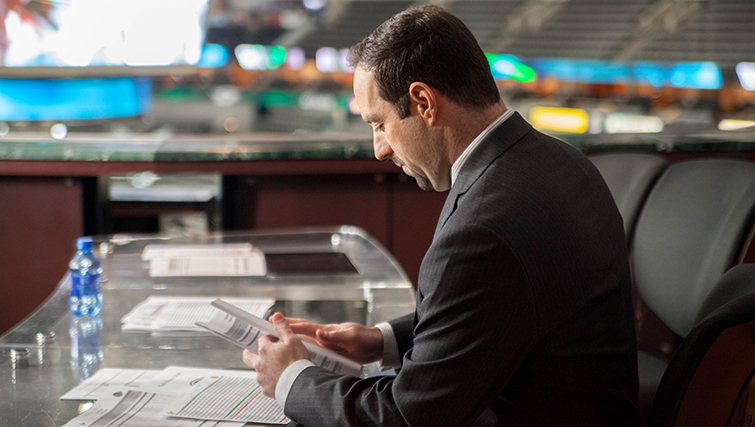
5:30 – Doors Open
As fans enter the arena (in an alarming amount of red Blackhawks jerseys) we head to the elevator bay and go back down into the control room. The room is abuzz with chatter over little game-time details. Danby places his laptop into his bag, and together we walk out to meet with the game personalities to go over last-minute notes.
As we turn the corner we encounter several players, like Tyler Seguin and John Klingberg, warming up by playing soccer in the tunnel. We walk past the team and head into a dressing room. There Danby meets with the Celena Rae, the on-camera personality that hosts game promotions and giveaways. She also leads the crowd in the STAR-Spangled Banner.
We head back out into the tunnel and towards another elevator bay, which will take us to the media level. As we near the elevator, Danby gets word that they have found a fan in a Sharp Blackhawks jersey who is willing to exchange for the signed Stars jersey. We hop on the elevator and head up to the top level.
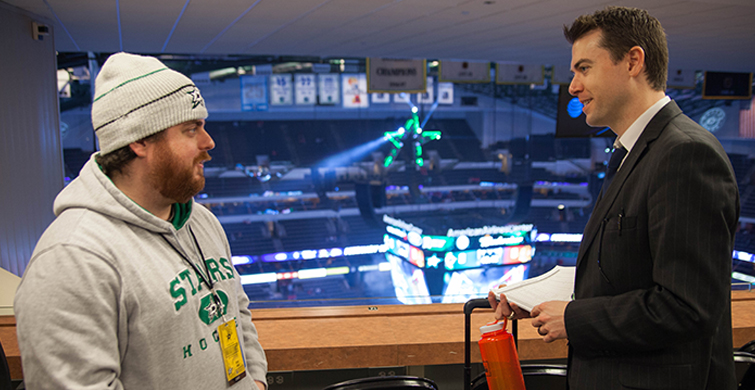
In the press box we run into the arena DJ, Michael Gruber. “Grubes” and Danby talk about a few of the planned bits and the soundtrack for the game. The two are hopeful for a good game. “We should kill them tonight,” says Danby. To which Grubes replies, “Hope so. If not, [the production crew] will kill it.”
Danby leads me down the corridor into his corner office. From here, he will direct the entire in-arena experience.
6:00 – Warm-ups
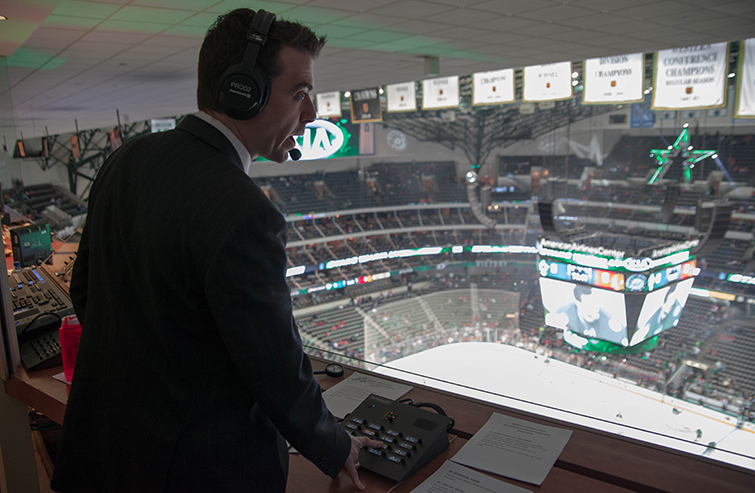
It’s just after six o’clock and Danby is getting situated high above the ice. He shares the corner box with the lighting technician, who is already setup for the game. Danby stretches and then puts on his headset as fans are finding their seats. He has a direct communication line to the control booth, as well as specific crew members scattered throughout the arena.
Danby hits the talk button to verify that the warmup video is ready and that the crew is set. He looks up to the scoreboard and notices that the nose of the Chicago logo is cutoff. He chuckles and calls down to visual effects director Jeff Neal to say he enjoys the little jest.
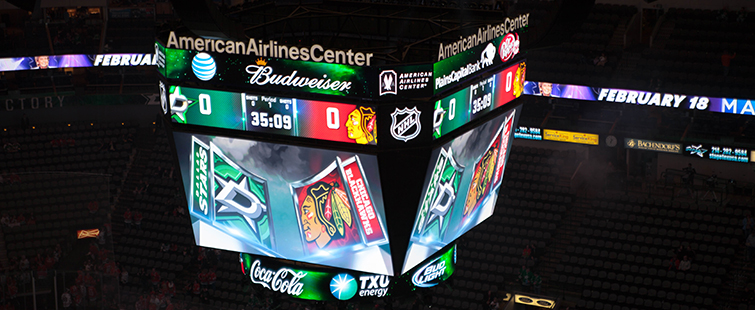
6:18 – Danby calls for VIXI to go onto the video board. VIXI is a broadcast platform for social media. Fans can send photos of themselves at the game via Twitter or Instagram. Once approved by the staff, the images are sent into a revolving slideshow on the video board. The slideshow will play until production begins.
6:20 – The first video of the night hits the board, an advertisement for the NHL, followed by a promo spot for Fox Sports. Beside Danby is a preview monitor showing the feed from four cameras, two font packages, and the Crossfire system — dubbed XFIRE A and XFIRE B. The camera crew is already on the hunt for Chicago fans in the crowd. When interesting characters are found, they will make note of the section number so they can cut to that fan later in the game.
6:28 – Danby says it’s go time for warm-ups. We get word that the Stars players are walking out of the locker room. The lights go out. Cue Music – Cue Lights – Take Camera 1. We are now live as the players hit the ice for warm-ups.
I leave Danby at his post and make my way back down to the control room for the first period.
GAME TIME – First Period
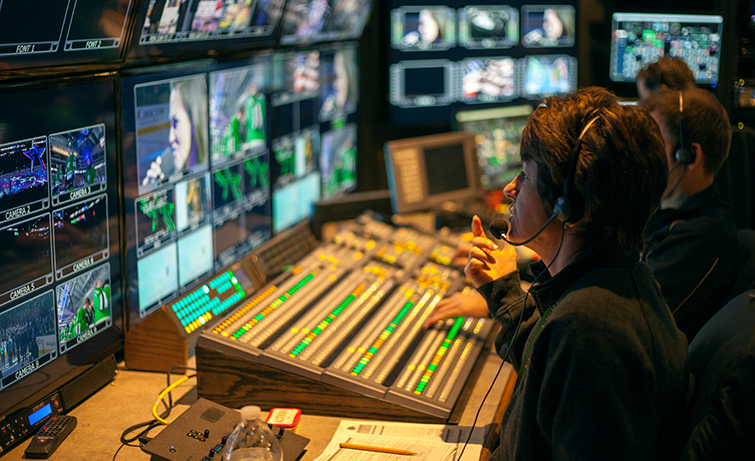
6:42 – In the control room, Terri McCormack is already calling shots, rapidly cutting between the four cameras that are up during warm-ups. Most staff members in the room are rocking back and forth in their chairs, dancing to the music in the arena. On the preview monitors, we see a child received an autographed hockey stick — the footage is immediately saved to be shown later during the game. The same goes for a family of three: the dad a Stars fan, mom a Hawks fan, and a baby at their first game.
6:45 – Warm-ups are now over. The teams leave the ice and we cut to an XFIRE package with another NHL ad.
6:50 – The director is calling for stats from the font operator, while also asking for a heads up when the player is on screen. The Zambonis are making laps as the previously mentioned Winnipeg and Colorado highlights play on the board. The highlights roll into a packaged interview with Patrick Sharp before returning to VIXI fan photos until the call comes in for the opening graphics.
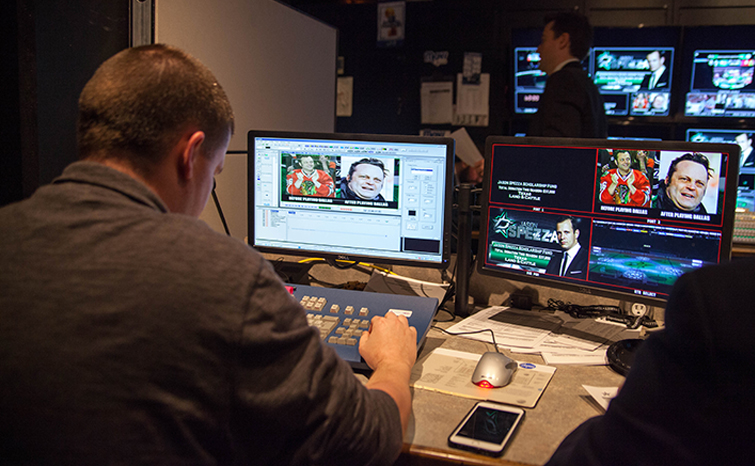
6:56 – Terri McCormack wishes everyone a good game and begins the countdown
Ten seconds! Five. Four. Three… Dissolve! Roll!
Cue Crossfire and the Stars opening package plays. The lighting technician turns on the fog machines attached to the giant star lowering from the rafters. Once the star is in place, the crew waits for their signal.
7:03 – I can see the players are lined up in the tunnel on the preview monitor. All of a sudden, the booth loses the feed from Camera 9. McCormack tells the cameraman to cycle his power.
7:04 – “Now taking the ice, your Dallas STARS!” We cut to Camera 3. The crowd watches the back of Captain Jamie Benn exiting the tunnel and skating onto the ice. We cut to XFIRE for the player intros.
7:05 – Camera 9’s signal comes back just as the national anthem begins. Celena Rae sings beside a military member, as the director cuts to Camera 9 for player reactions.
7:07 – Dissolve to a graphics package as cameras move into their positions.
7:08 – The puck drops and things get intense fast. Seconds into the game, the Stars are called for a penalty. The XFIRE Penalty Kill elements hit the video board immediately — but it doesn’t matter. Chicago scores thirty-four seconds into the game.
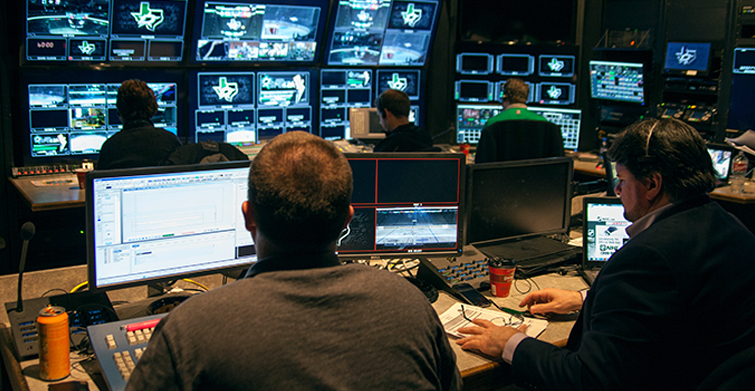
Perhaps the most interesting note out of that rapid run: the crew still reacted as fans. They’re disappointed in the start, but still hopeful the team can quickly turn things around.
During the stoppage after the goal, the director calls for a close-up shot of Jamie Benn. When the camera sets, they take the shot and add a lower third. They stay on Benn until the puck drops, and then they cut back to the TRUCK.
That’s the standard routine for game play. During play, the TRUCK camera is primarily used. This wide shot follows the action of the ice. As soon as a whistle blows, they cut to a close-up for any of the other in-arena cameras. When a particular shot is needed, a call is made down to the camera crew to find a player.
As the TRUCK is once again fed to the video board, McCormack calls, “Goose on the whistle. Find me Goose.” Goose is the nickname given to Stars defenseman Alex Goligoski. As soon as the whistle blows, they cut to a close-up of Goligoski and add a lower third with his game stats.
During longer breaks, video bits start to roll.
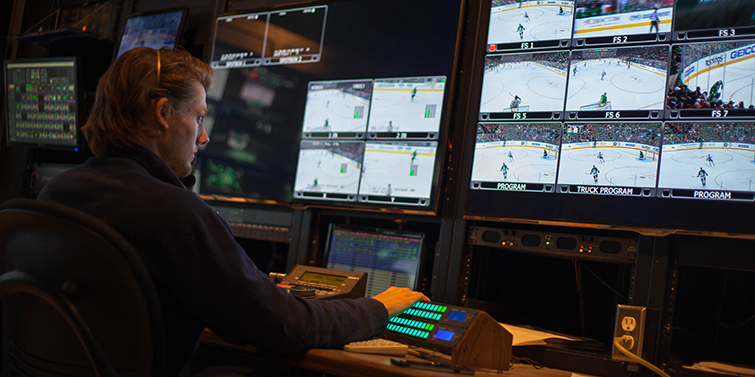
7:32 – The puck flies out of play. “Replay! Anyone got it?” asks McCormack. “Working on it. Ready Blue,” comes from the other side of the room. “Take Blue.” Blue is the name of the second replay desk. Out on the video board, the crowd can already see the replay in action.
7:33 – During the stop in play, the director cuts to XFIRE. A previously taped video of the mascot beating up a Chicago fan plays as the cameras prepare to cut live to the fan giving up his Sharp jersey. The board goes live during the jersey exchange. The mascot, Victor E. Green, takes the Blackhawks jersey and begins to wipe his bottom. The entire booth starts to laugh and misses a cue for a cut. “Ah! Well, there goes the Emmy for tonight.”
7:38 – “Damn,” echoes throughout the control room as Chicago scores for the second time.
7:40 – Cheers erupt as Tyler Seguin scores for Dallas. XFIRE plays the GOAL elements on all the ribbon boards as the cameras cut to fans around the arena.
FONTS! 91 Seguin Ready? Replay! Ready with the Seguin goal? Go!
7:45 – Chicago scores a third goal. “C’MON!” roars from the back of the booth. With little time left in the first period, Chicago will head into intermission with a 3-1 lead.
7:55 – Players leave the ice as XFIRE plays local advertisements until the replay team is ready.
7:57 – The first period replays are now on the board.
During intermission, the entertainment team will take the ice, as everyone in the booth resets for the next period. At this time, I exit the control booth to roam the arena for the remainder of the game.
GAME TIME – Second and Third Period
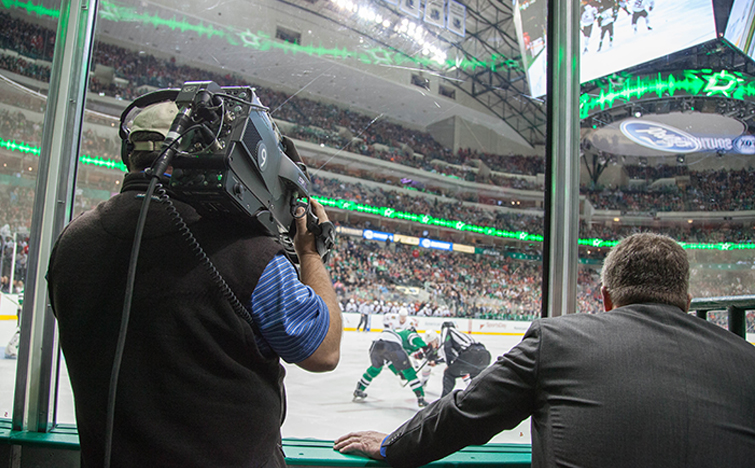
During the second period, I make my way down to the Zamboni entrance to catch the camera crew at work. Armed with a Grass Valley LDX 80 Series camera and an apple box, the cameraman stands at ice level catching many of the action shots.
Opposite the Zamboni entrance is the Ice Girls entrance, where an in-arena cameraman captures both game footage and crowd reactions. As I head to his vantage point, a police officer asks my intentions. He finds it hard to believe I’m there to watch a cameraman and not the ladies. I’m pretty sure I’m the first person to ever say so. As luck has it, we score a great photo of the cameraman capturing footage of the crowd that is sent live to the video board behind him.
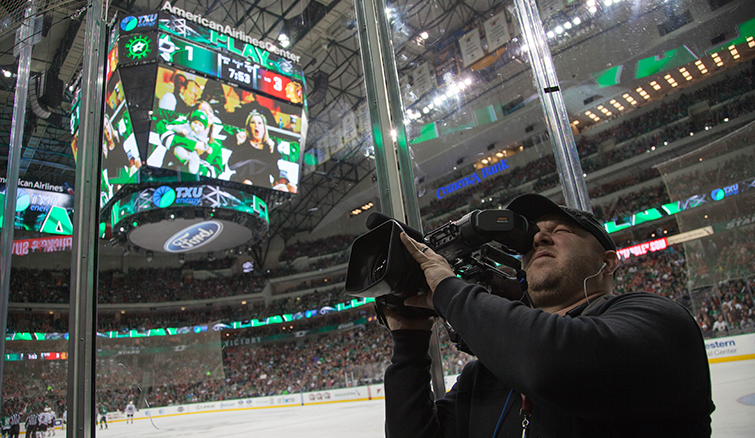
The second period draws to a close. Chicago has taken a commanding 5-1 lead. I’ve kept my eye on the video board, only to notice that some of the extra jokes planned at Chicago’s expense have not been shown. They’ll be shelved for a later game against the team, one in which the Stars have a better chance.
The second period highlights are sent to the video board, then the packaged “Chicago fans texting” video plays. The big reveal of a Chicago fan texting while on a blind date with a Stars fans scores big laughs.
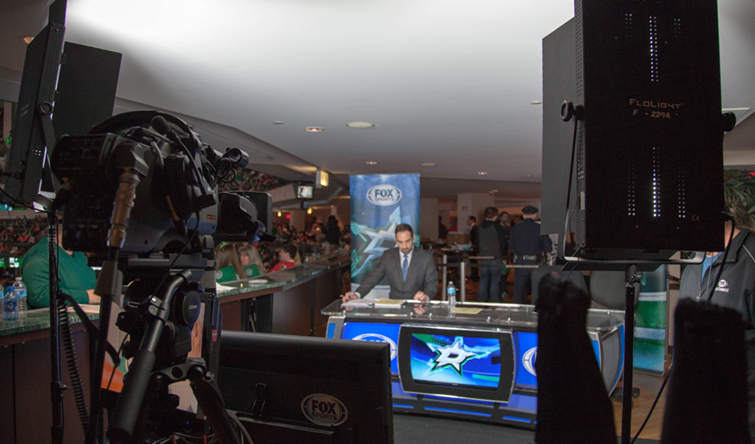
During intermission I head back up to the platinum level to catch Josh Bogorad live on Fox Sports. He is accompanied by a single cameraman and a producer timing out the commercial breaks.
I make my way past fans and toward the broadcast booth as intermission wraps up. There I catch a reporter from WGN in Chicago finishing his recap of the first two periods.
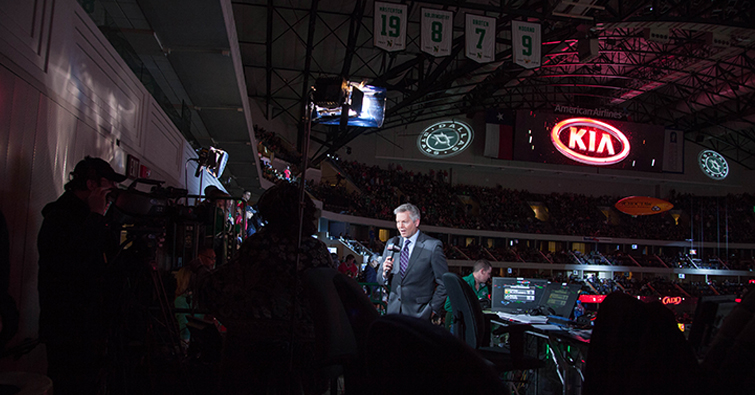
The rest of the booth is set up for Dallas play-by-play and color analyst duo Dave Strader and Razor Reaugh. At the center of the booth is a table at which the pair stands. They are not featured on camera during play, so they are free to watch their monitors and keep up with stats. On the edge of the broadcast booth are two barstools, a single Grass Valley camera, and two ARRI 650 lights.
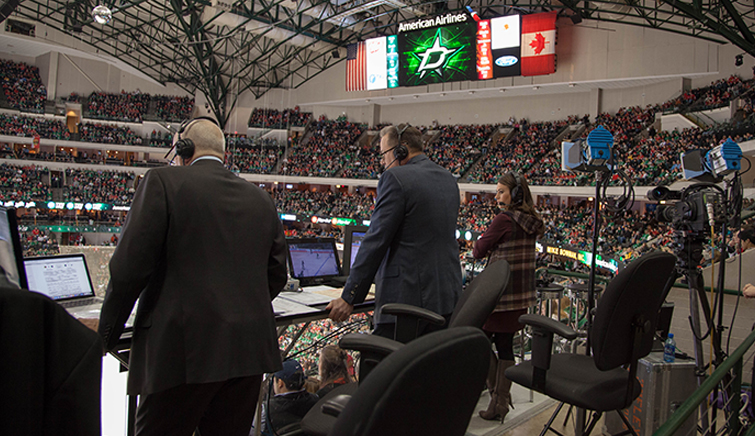
I finally make my way up to the 300 section to see the two cameramen up in the fixed locations high above the fans. From their vantage point, they use Grass Valley cameras with a Canon DIGISUPER 76 or Fujinon DIGIPOWER 99 lens to capture the games. These two cameras are semi-permanent and used for both Dallas Stars and Dallas Mavericks games. As soon as the third period draws to a close, the cameras are covered and locked in position.
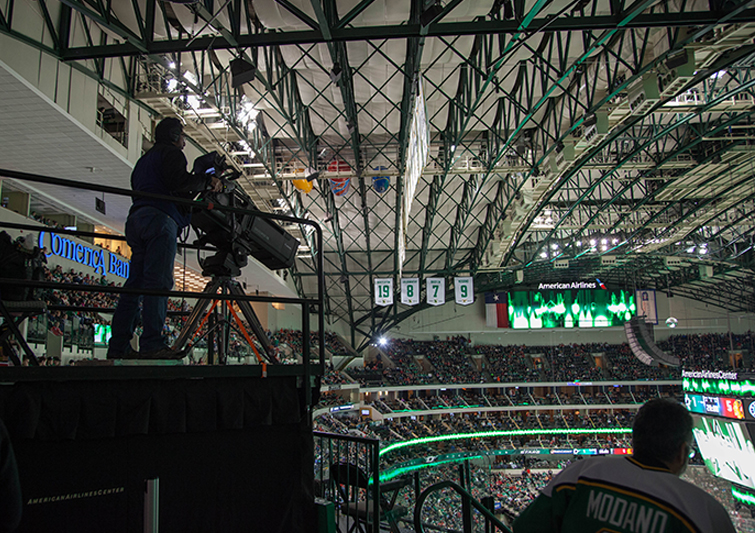
The video board returns to a graphics package as fans exit the arena. It’s then I check my phone to see that the NHL Facebook account has already shared video of Chicago’s third goal.
Just after midnight, the Dallas Stars have shared the Inside Edge video recap. By eleven o’ clock the next morning, the Stars Facebook page shares links to the game recap, post game interview with Coach Lindy Ruff, and final thoughts from Razor.
Final Notes
Though it was a tough loss for the team, the media department still offered fans quite a few laughs throughout the game. The speed of their production is nothing short of amazing, as this crew has every little detail down. By the time the recaps hit the web, they prep for their next home game.
Production wise, this crew showed off tremendous talent. The culture has grown out of the leadership of both Jason Walsh and Jason Danby. The two make a very strong case for being the best producers in the league.





